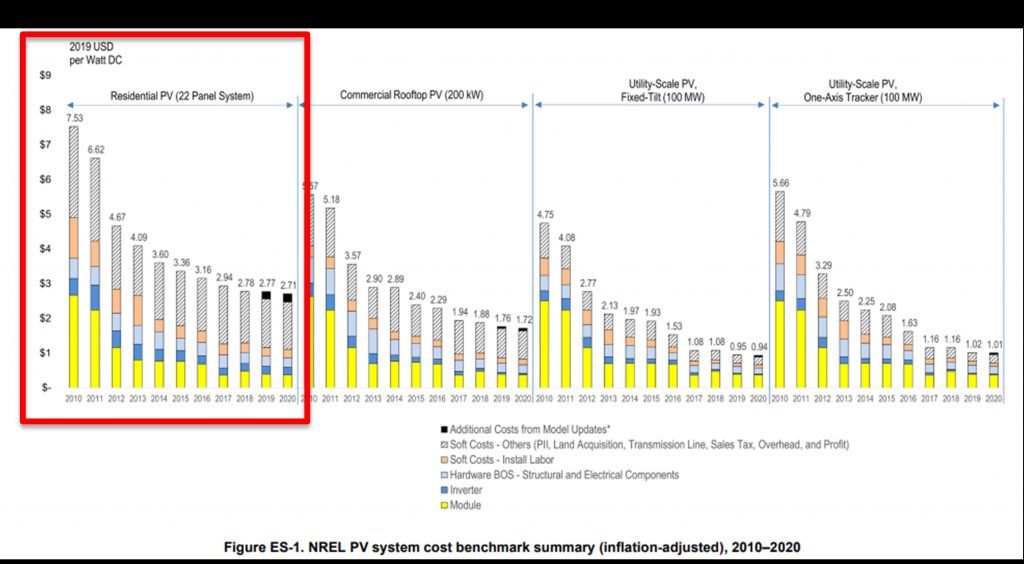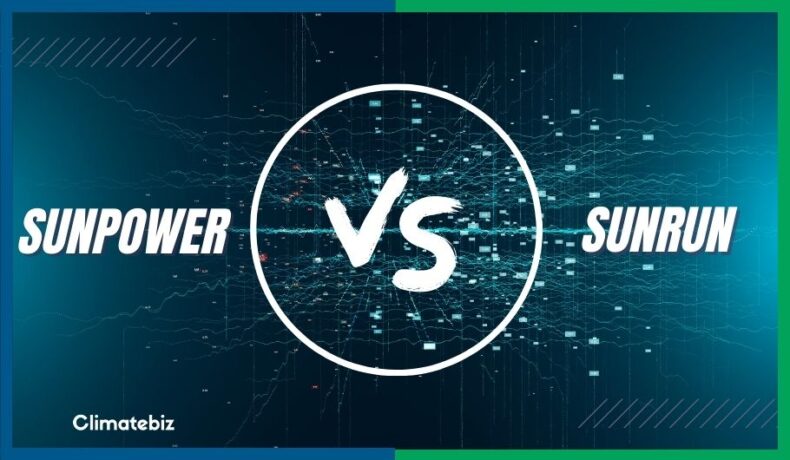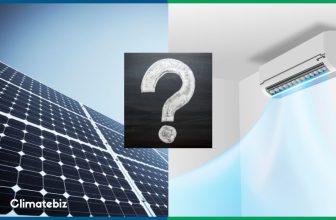
The age-old question: Will solar panels get cheaper?
Our quick answer to you is YES.
Manufacturers have already made solar cheaper by 80% since 2000 and will continue to drive the price down further. However, ClimateBiz experts found recently that the pace of price reduction has slowed down.
If you are reading this post, you most likely belong to one of the two (2) groups of people who are meant to find this:
The Newly Woke
You are new to the field of green energy. In the past, you used electricity without thinking much about where it came from. But recently, you’ve seen more posts on social media about green energy. Hearing more stories from friends about the clean energy movement.
And something inside you clicked.
“This feels right,” you might think.
Now, you are eager to learn more about starting a more sustainable lifestyle.
Well, we want to tell you right off the bat that there are some steep learning curves ahead. But don’t worry, because we are here to help! We promise that our articles are made to deliver the right balance of value and information to our readers—may they be beginners or seasoned experts in green energy.
The Rational Investor
You did all your homework — watched YouTube videos. Read articles and blog posts. You had conversations with friends who have already switched to green energy. Essentially enough to convince yourself that a solar panel project is a profitable investment. However, there is still one question your inner voice is asking you to confirm:
“Is this the right time?”
“Maybe the price will go down even more if I wait.”
“Maybe we could time the solar panel market better.”
In this article, we think vying for a better deal when it comes to installing a solar project is a common pitfall that people encounter. Let’s get into some facts first, then get back to why this is our opinion.
Affiliate Disclaimer
Table of Contents
Will Solar Panels Get Cheaper?
There are countless sources out there that vary on the average price for solar panels. This is understandable since each independent study has different assumptions when it comes to its financial models. However, after scrutinizing most of them, we conclude that they all agree on one thing: the price of solar panels went down like crazy over the past decade. However, the rate at which they decreased decelerated in the past couple of years.
Taking a look at the trends
Now, for this section, we will rely on the good old noggins of our friends at the National Renewable Energy Laboratory (NREL). We took a look at their cost benchmark reports during 2018 and 2020, and here’s what we found.
Based on the figures in their report, we can see that the residential solar installed costs have stopped dropping recently (see figure highlighted in the red box below). As of today, the PV cost benchmark is $2.7 per Watt DC (WDC) for residential PV systems.


The figure and table tell you that solar panels have become more compact, efficient, and cheaper in recent years, all thanks to the advancement of technology. Of course, market forces play a significant role in propelling the growth of clean energy forward.
It is also important to point out that the PV material used for NREL’s 2018 study is polycrystalline, whereas the 2020 study used monocrystalline. Recall in our previous 5kW case study the difference between polycrystalline and monocrystalline silicon panels. Go figure out why that comparison is noteworthy.
So, will it go down some more?
Yes, but we see no additional benefit in waiting longer since most of the cost components left are hard to budge. The report of Bloomberg New Energy Finance (BNEF) projects that the price of solar will drop one-third by 2030. Meaning, your $2.7/Watt investment today will be $1.8/Watt after a decade. This $0.9/Watt savings is not worth the wait.
The Cost Components of Installing Rooftop Solar
As far as cost components are involved, the cost to install a solar photovoltaic (PV) system includes two broad cost categories: Infrastructure cost and Intangible cost.
- The infrastructures. Hardware costs are for all the materials required when you build your solar system. These are your modules, inverters, racking, and electrical wiring.
- The intangibles. Of course, most of you would agree that there is some benefit to it if you had help from experts in the field. In exchange for your convenience, their payment is what you call the “soft costs” of your solar rooftop project. These cover the cost of labor, permitting, and administrative costs.
Looking at the typical residential PV system cost breakdown (see NREL Figure above), you would observe that most of the overall 65% price reduction over the last decade comes from reduced hardware costs. Soft costs are hard to reduce since it involves livelihood and expertise which are likely to be fixed.
You want to be paid fairly for doing your job well, right?
This is why we believe that further cutting down on solar installation expenses would be a hard bargain.
How Much Cheaper Has Solar Energy Become?
Now, let’s take a step back and appreciate the odyssey of the residential rooftop solar industry. We think that doing so will help you understand the gravity of this breakthrough in the power sector. It is not only until the 21st century where energy consumers can conveniently choose green energy over fossil fuel to supply their electricity.
As mentioned earlier, the national average benchmark price for residential solar systems (3-10kW) in the United States is about $2.7/Watt DC or $3.1/Watt AC. This is already considered a massive leap, given that the price of installing solar panels was at $12/Watt back in 2000.
To drive the point further, let’s do a sample case scenario:
Investing in solar in 2006 and 2021: A comparative study
Meet your Uncle Bob and Aunt Fanny. They have been believers in the green energy movement since they saw Vice President Al Gore’s well-made climate change argument back in 2006. At that time, Solar panel costs decreased by $2/W compared to its Y2K price, falling to $10/W.
We know that the price is not that enticing if you look at it in our present time. However, given that the cost of residential electricity price rose 10% that year (see Figure below), Uncle Bob and Aunt Fanny invested in a 5kW solar system at $50,000.00. They had the thing financed through their guy (or gal) and have enjoyed free, clean electricity ever since while reducing their electricity bills.

Fast forward to today, the same 5kW solar rooftop will cost you only about $15,000.
To quote the iconic words of Mr. Jesse Pinkman from Breaking Bad, “Yeaaahhh, science!!!”
What Do Solar Panels Cost Per State?
So, the $15,000 is based on the fact that solar installation costs play around $3/Watt. If you want prices specific to your geographic location, we tabulated some data below to give you an idea of how much solar systems cost per state.
| STATE | COST PER WATT ($/W) | STATE | COST PER WATT ($/W) |
| Arkansas | $2.49 | Minnesota | $3.04 |
| Arizona | $2.33 | Montana | $2.77 |
| California | $2.66 | North Carolina | $2.80 |
| Colorado | $3.12 | New Hampshire | $3.07 |
| Connecticut | $3.11 | New Jersey | $2.67 |
| Washington D.C. | $3.43 | New Mexico | $3.15 |
| Delaware | $2.61 | Nevada | $2.34 |
| Florida | $2.46 | New York | $3.14 |
| Georgia | $3.01 | Ohio | $2.67 |
| Iowa | $2.70 | Oregon | $2.81 |
| Idaho | $2.66 | Pennsylvania | $2.90 |
| Illinois | $2.88 | Rhode Island | $3.14 |
| Indiana | $2.98 | South Carolina | $2.93 |
| Louisiana | $3.10 | Texas | $2.70 |
| Massachusetts | $3.04 | Utah | $2.71 |
| Maryland | $2.99 | Virginia | $2.92 |
| Maine | $2.61 | Vermont | $2.91 |
| Michigan | $3.01 | Washington | $2.58 |
Why the price difference per state?
Okay, give us a second to crack our necks before we go full nerd up in here.
As discussed in the previous section, there are many components under the cost curve for installing a solar rooftop. However, a lot of variables affect the price of your solar system.
Size Matters
Based on a white paper published by Berkeley Labs, each hardware and soft cost variable has a varying effect on the solar rooftop price. The ones that affect the price the most are system size and ground mounting.
For example, solar installation companies can give you a lower price per Watt by increasing your system size, say from 5kW to 10kW. However, we cannot expect the same discount if you opt to change other line items in your solar rooftop project, such as inverters, DC optimizers, modules, etc.
What has that got to do with the varying prices per state?
Location, location, location
Some of you probably already figured it out, and Uncle Bob is proud of you. The solar size requirement caused the price variation of each average household per state. On top of that, you also have to factor in state-specific variables like cost-of-living, retail rates, permitting processes, etc.


If you look at most of the solar installations made, they are prevalent in sunnier areas (see the figures above). That goes without saying that the system size per household is more significant in those areas as well.
In hindsight, it may seem like common sense now that you think about it. But, as always, it is satisfying to see how we scientifically confirmed our hunch.
Is It Cheaper To Build Your Own Solar Panels?
Yes, you would be taking out a large sum of soft costs if you did your solar rooftop system yourself. But before you bid Iris (the solar installer) goodbye, let’s look at the trade-offs.
The Benefits:
By going DIY, you would cut costs on the following:
- Permitting and transaction fees;
- Solar panel integration to your home electric system via the electric panel. You know, the one with lots of circuit breakers and fuses;
- Corporate costs and customer acquisition costs; and
- Iris’s salary
Suppose you are capable of safely installing a solar rooftop in your home and securing all the available solar incentive programs. In this case, we estimate that you would cut down your project cost from $2.7/Watt to $1/Watt. With this, your installed solar panels are cheaper by 65-70%. Quite impressive!
The Challenges:
However, Mr. or Ms. Little DIY, we encourage you to think about it one more time. Would you really bet that you could do it as well as Iris here?
Please go on. Look her in the eye and tell her you could. We’re waiting.
Are you sure that the wiring configuration in your electric panel is correct and adequately sized? Are you betting that you could accomplish the same quality of work as a well-trained solar rooftop installer? Are you familiar with all the solar incentive programs in your area? Are you ready to process your distributed energy resource plan?
“Distributed energy re- wha-?”
Conclusion:
We agree that shaving $10,000 off your initial solar panel project will make it cheaper. This also means that you will get your money back quicker. However, if you choose this path, we recommend taking at least some training centered around safety. After that, get to know what incentives you are entitled to receive. Call it your business model, if you will.
For those who value simplicity and convenience but want the savings, climbing up the steep learning curve before deciding to install a solar rooftop is already an admirable feat. There is no shame in leaving the implementation to the experts.
Why Are Solar Panels Getting Cheaper?
We are pretty sure by now that you get the picture of why solar panels are getting cheaper. Rational investors today, even those who don’t value green energy that much, have been relentlessly investing in solar panels over the past half a decade. This is mainly because solar panel prices already hit the pavement.
The reason manufacturers can drive down the solar panel costs so much is due to the economies of scale. Each year, they continue to produce GIGAWATTS of solar capacity because the government gave them attractive investment signals through incentive programs and policy support. The government created these policies because world leaders agreed to address climate change issues more seriously in 2015—and bam! As we said in 2006, Bob’s your uncle.
Why Are Solar Panels Cheaper to Make in Other Countries?

Despite all this motivation to drive the cost curve down, the figure above still shows that the US is the most expensive place to put up residential solar among its peers!
The US solar price is 33% higher than Brazil and more than twice the cost in Germany. What it fails to say, however, is the why. We did some digging and found an explanation.
According to Burkhardt et al., city-level permitting and other local regulatory processes on residential PV prices in the United States are the main culprits. Their study identified these cost components to average $3200 in your 5kW rooftop solar project. That’s a whopping 20% of the total cost.
That is why we cannot entirely blame you for wanting to go DIY on your solar project. Some prefer to do the heavy lifting to avoid the red tape.
This issue is something that the government could not change overnight.
It is heavily rooted in how the United States crafted its policy around green energy.
Now, just in case you want to do deep dives into this topic, we recommend checking out Craig Morris’s take on the topic in his book, Energy Democracy.

Should I Buy Solar Panels Now, Or in The Future?
Let us say it one last time: For solar energy, the price reduction has already reached its saturation point. If you are still looking for more earning potential from this venture, we suggest looking into “green energy product bundles.”
If that phrase is new to you, get ready to become a level two (2) clean energy consumer. Let’s look at a very recent development in clean energy tech.
In California, lithium-ion batteries are soon going to become a hot pick. Why? The utility SDG&E recently released guidelines about implementing new policies related to demand-side management and time-of-use rates. This new initiative benefits those who have both solar and storage installed in their homes.
For example, a typical net metering solar incentive usually yields a solar rooftop owner about 26 cents per kWh during the day. However, the payment increases when you have an energy storage device installed along with your solar panel. You will enjoy 47 cents per kWh since a solar-plus-storage combination helps SDG&E resolve a power system phenomenon called the “duck curve.”
That is just the tip of the iceberg for unlocking the full potential of green technology. Like we said in the introduction, a common pitfall for people looking to invest in this project is that they often get too hung up with solar as their only investment vehicle. However, the reality is that solar plays one role among many in the grand scheme of the clean energy transition.
Final Thoughts
Most of us don’t know it, but it took solar panels about seventy (70) years to become commercially mature. Bell Laboratories developed the first solar PV in 1954, and it took plenty of great minds for this technology to come this far.
We are confident that it will continue to develop. However, we recommend that you already buy into it if you still have second thoughts. Don’t waste all the effort you already invested. This fruit is ripe for picking, and there are greener pastures to explore. Claim your solar savings.









